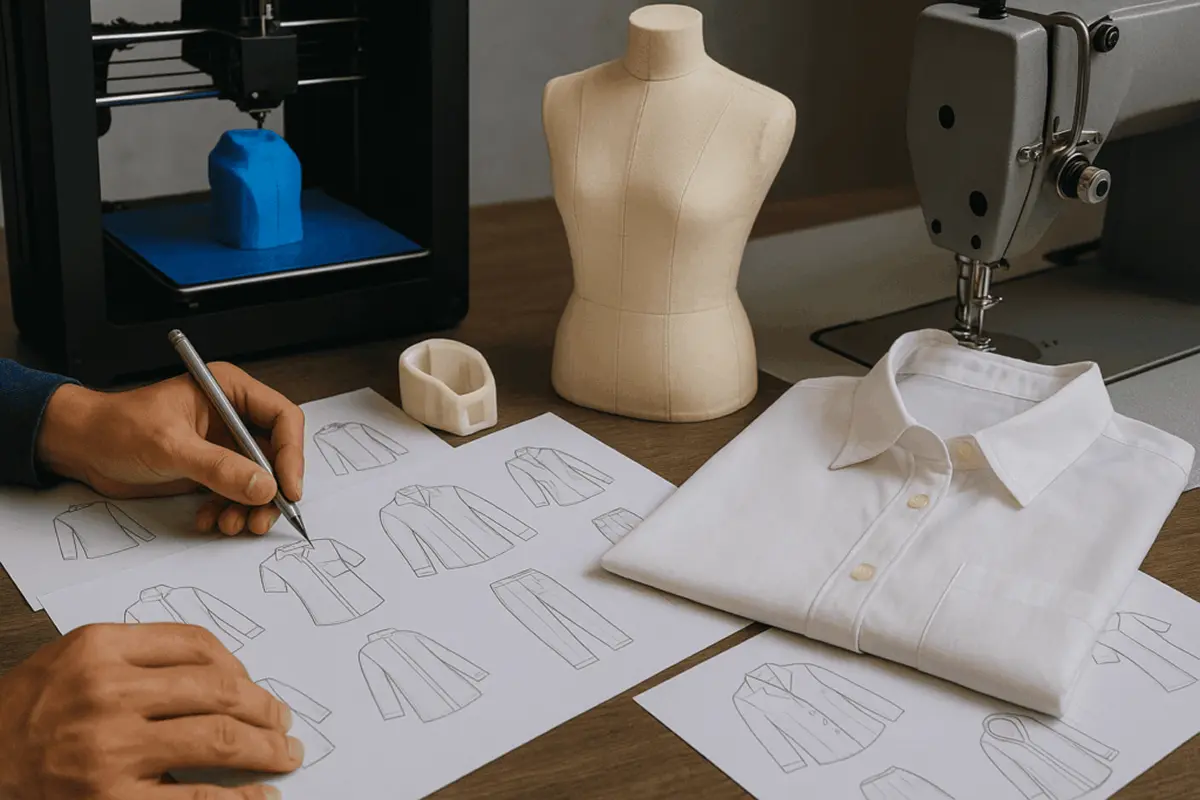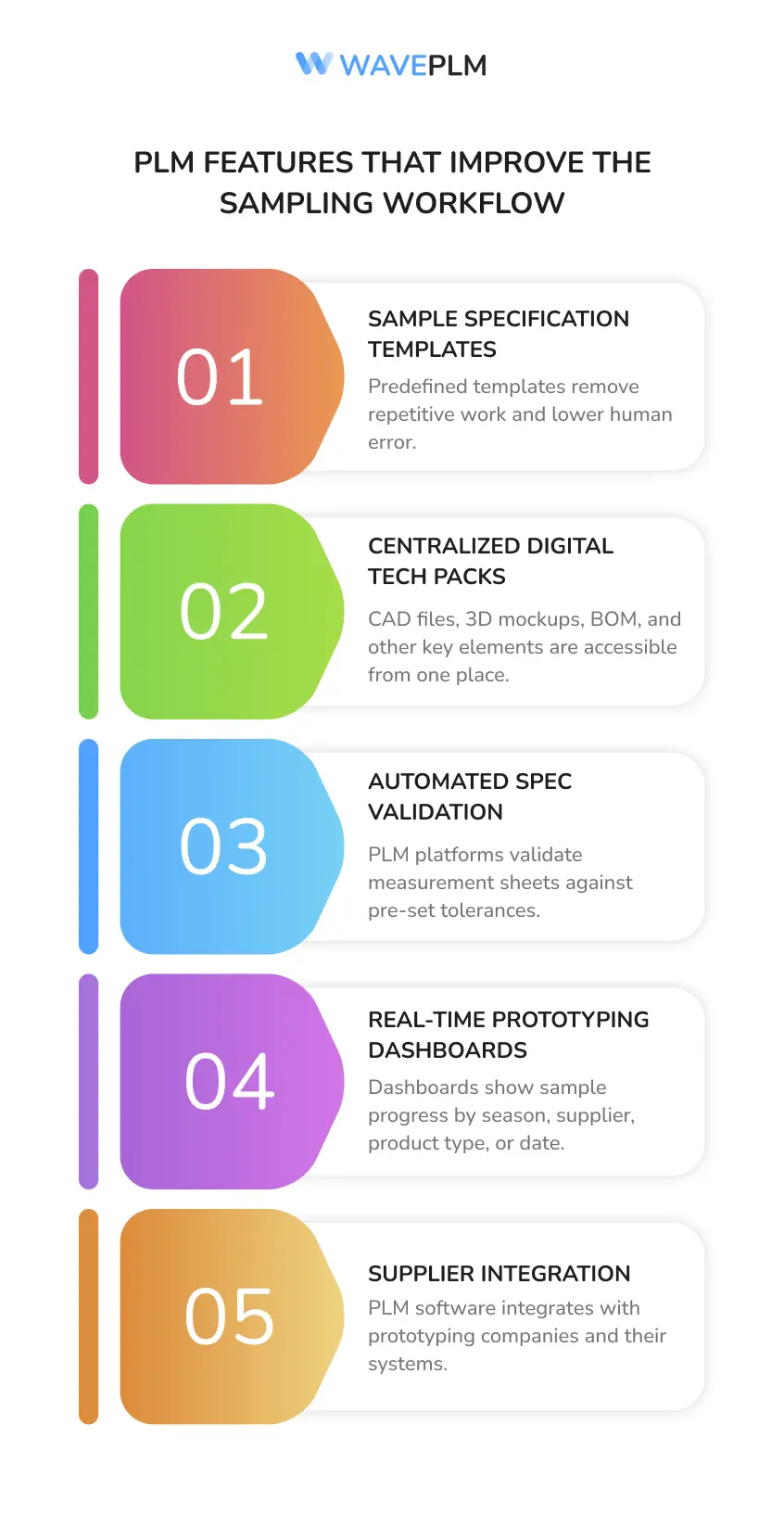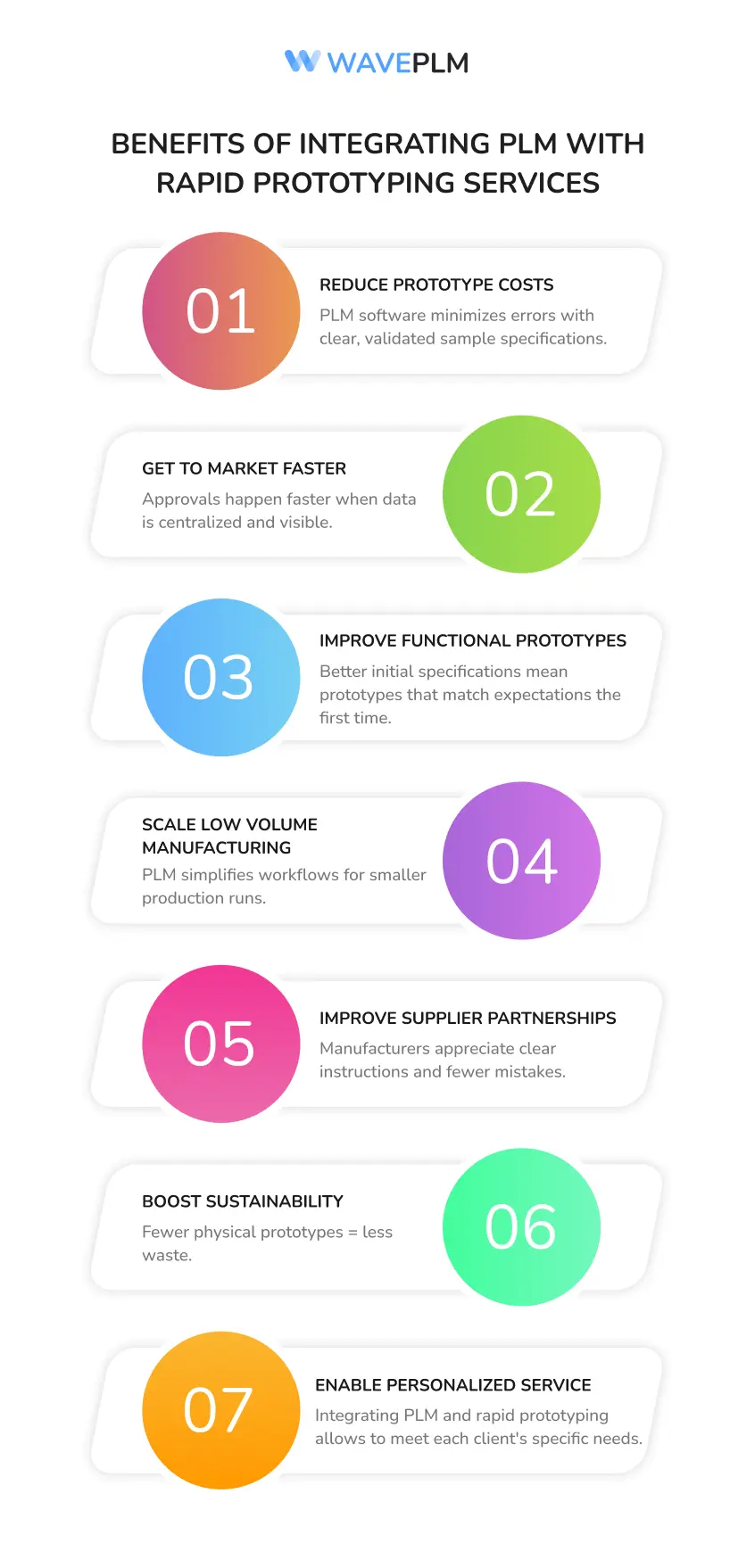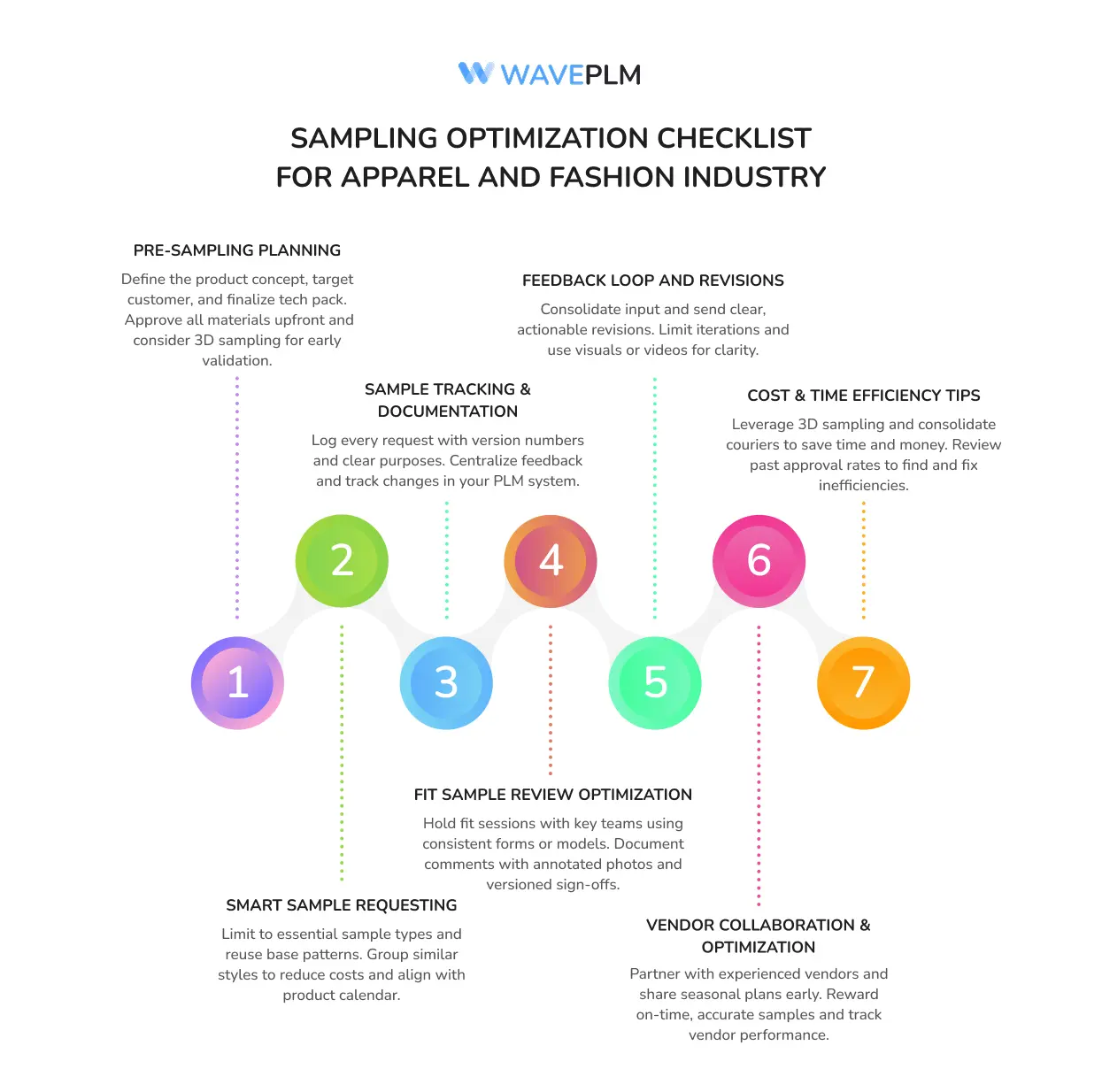
Sampling is where design creativity intersects production practicality. For fashion houses, this stage can both make or break a line. However, all too often, the sampling phase is fraught with slow-downs, misunderstandings, and unnecessary expenses. Thankfully, with appropriate digital technology —namely PLM software connected with rapid prototyping services — companies can make their prototyping processes simpler and more expedited, transforming sampling from a stumbling block into a quick, efficient, and consistent phase of product creation.
PLM software and rapid prototyping services empower fashion brands to turn their vision into reality by transforming creative concepts into tangible samples.
This definitive guide walks you through how fashion companies can transform their sampling workflow with fashion PLM software and high-end prototyping solutions.
Understanding Rapid Prototyping Services in Fashion
Rapid prototyping refers to techniques that quickly transform digital designs into physical prototypes. These services are a key component of the product development process and help teams move from concept to testing with minimal delays. When rapid prototyping is combined with PLM, the sampling experience becomes faster, more accurate, and easier to scale.
|
Type of Prototyping Service |
Description |
|---|---|
|
3D sampling |
Visualize designs before making physical samples |
|
Manual prototyping |
Initial hand-made models used to test ideas |
|
CNC fabric cutting |
High-precision, automated cutting from CAD files |
|
Digital printing for textiles |
On-demand fabric printing for custom designs |
|
Fit sample creation |
Functional prototypes for testing fit and sizing |
|
Pre-production sample (PPS) |
Final product version approved for production |
Rapid prototyping services support product design by enabling the creation of both digital and physical product prototypes, allowing teams to visualize, test, and refine their concepts efficiently. Prototype manufacturers use a variety of materials, such as plastic, plastics, and aluminum, to create accurate physical products for testing and development. Prototyping companies and prototype manufacturers offer these services to help brands create accurate physical prototypes. But without a centralized data system, even the best manufacturing partner may struggle to keep up. That’s where PLM software plays a critical role.
The Role of PLM Software in the Prototyping Process
PLM (Product Lifecycle Management) software connects everyone involved in the product development process—designers, developers, sourcing agents, engineers, and manufacturers. Collaboration between engineers and other team members is essential, as engineering expertise ensures that prototypes are designed for manufacturability and optimized for quality and cost. PLM serves as the central hub where every detail about a product’s lifecycle is stored, updated, and shared in real time.
|
Sampling Stage |
Without PLM |
With PLM Software |
|---|---|---|
|
Tech pack sharing |
Sent via scattered emails |
Hosted and updated in real-time |
|
Measurement specifications |
Excel sheets prone to errors |
Auto-validated against tolerances |
|
Sample feedback and changes |
Tracked in separate documents |
Logged directly in the tech pack |
|
Supplier collaboration |
Manual updates and delayed feedback |
Integrated supplier portal with notifications |
|
Sampling status tracking |
Confusing email threads or spreadsheets |
Clear dashboards with filtering tools |
With PLM, every stakeholder sees the same version of the sample data. It keeps the prototyping process organized and traceable. Some PLM platforms now incorporate artificial intelligence to automate routine tasks and enhance workflow efficiency.
Digital Manufacturing Technologies in Fashion Prototyping
Digital manufacturing technologies have dramatically accelerated the fashion prototyping process, empowering brands to move from concept to physical sample with unprecedented speed and precision. Tools like 3D printing, computer-aided design (CAD), and computer-aided manufacturing (CAM) enable designers to create intricate patterns and innovative shapes that would be difficult or time-consuming to achieve by hand. These advancements in digital manufacturing allow for rapid prototyping, where ideas can be transformed into tangible samples in just a few hours, significantly reducing lead times and development cycles.
By leveraging rapid prototyping services, fashion companies can quickly iterate on designs, test new concepts, and refine products before committing to full-scale production. This not only helps brands get to market faster but also ensures higher product quality and greater customer satisfaction. Digital manufacturing also supports on-demand production, allowing companies to respond to market trends and consumer demand with agility. As a result, the integration of digital manufacturing technologies into the prototyping process is now essential for any company looking to stay competitive in the fast-paced world of fashion product development.
Physical Prototyping Methods for Apparel Samples
While digital tools have transformed the prototyping landscape, traditional physical prototyping methods remain a cornerstone of apparel sampling. Techniques such as sewing, draping, and pattern making allow designers to create functional prototypes that can be evaluated for fit, comfort, and construction before moving to final production. These hands-on methods are invaluable for testing the tactile qualities of fabrics and ensuring that the physical prototype meets both design intent and quality standards.
Physical prototyping is often enhanced by digital manufacturing technologies. For example, designers can use CAD software to develop precise digital patterns, which are then used to cut fabric or sheet metal components with CNC machining or laser cutting. This hybrid approach enables prototyping companies to deliver high-quality, accurate prototypes that reflect the intended design and are ready for further testing or presentation. Services such as sheet metal fabrication and CNC machining, offered by leading prototyping companies, provide the flexibility to create custom parts and components for apparel samples, ensuring that every prototype is both functional and production-ready.
PLM Features That Improve the Sampling Workflow
Let’s break down the features within PLM software that directly improve sampling and the rapid prototyping process. PLM software enables teams to manage multiple sampling projects simultaneously, improving organization and oversight.
1. Sample Specification Templates
Predefined templates remove repetitive work and lower human error. Teams can focus more on refining the physical prototype and less on admin.
|
Field |
Example |
|
Product Type |
Hoodie |
|
Size Range |
XS – XL |
|
Fabric |
Organic Cotton |
|
Color |
Pantone 17-5104 TCX |
|
Trim |
Ribbed cuffs |
|
|
Logo, front placement |
|
Notes |
Double-needle stitching on hem |
2. Centralized Digital Tech Packs
All product specs—size charts, materials, product images, construction notes—are stored in one live document. CAD files, 3D mockups, BOM, and other key elements are accessible from one place.
3. Automated Spec Validation
PLM platforms validate measurement sheets against pre-set tolerances. Engineers and manufacturers receive a spec sheet they can trust, reducing mistakes.
4. Real-Time Prototyping Dashboards
Dashboards show sample progress by season, supplier, product type, or date. Filters and visual indicators help project managers identify delays quickly.
5. Supplier Integration
PLM software integrates with prototyping companies and their systems. Manufacturers can access up-to-date information and upload sample images, revisions, or approvals.

Manufacturing and Production: Bridging Prototypes to Final Products
Transitioning from prototype to final product requires a robust manufacturing and production process that balances speed, cost, and quality. Fashion companies rely on advanced manufacturing techniques such as injection molding, laser cutting, and CNC machining to produce production-quality parts and apparel samples at scale. These rapid manufacturing methods enable the efficient creation of large quantities of samples or finished goods, ensuring that products are delivered on time and within budget.
Partnering with a reliable manufacturing partner is crucial for maintaining consistency and meeting quality standards throughout the production process. Companies like Protolabs and Carbon 3D offer a suite of digital manufacturing services—including 3D printing, CNC machining, and injection molding—that support everything from low volume production to mass production. By utilizing these services, fashion brands can streamline their manufacturing process, reduce costs, and bring innovative products to market faster. The ability to quickly scale from a single prototype to full production is a key advantage in today’s competitive fashion industry.
Quality Control and Assurance in the Sampling Process
Ensuring that every sample meets the highest standards is essential in the product development process. Quality control and assurance practices are integrated at every stage of prototyping to verify that prototypes and final products align with design specifications and customer expectations. This includes rigorous inspections, material testing, and functional assessments to catch defects early and maintain consistent quality.
Prototyping companies specializing in rapid prototyping, such as 3ERP, provide comprehensive quality control services to support fashion brands throughout the development cycle. By implementing robust quality assurance protocols, companies can minimize the risk of costly errors, reduce waste, and ensure that each prototype is a true representation of the final product. This focus on quality not only enhances the reliability of the prototyping process but also builds trust with customers and manufacturing partners, ultimately leading to better products and stronger market performance.
Supply Chain and Logistics: Accelerating Sample Delivery
A streamlined supply chain and efficient logistics are vital for accelerating sample delivery and keeping the product development process on track. Fashion companies must coordinate with prototyping companies and manufacturing partners to ensure that samples are produced and delivered quickly, minimizing lead times and enabling rapid response to market trends. Techniques such as just-in-time (JIT) manufacturing and drop shipping help reduce inventory costs and speed up delivery, ensuring that samples reach decision-makers and customers without delay.
Digital manufacturing technologies further enhance supply chain efficiency by enabling real-time tracking, instant quoting, and seamless communication between all stakeholders. Prototyping companies like UPTIVE Advanced Manufacturing offer integrated logistics services, ensuring that every step—from prototype creation to final delivery—is managed with precision and reliability. By optimizing supply chain and logistics operations, fashion brands can reduce lead times, improve delivery accuracy, and maintain a competitive edge in a fast-moving market.
Benefits of Integrating PLM with Rapid Prototyping Services
When apparel PLM software and rapid prototyping are integrated, the benefits multiply:
- Reduce Prototype Costs: Errors in communication, design, or sizing are expensive. PLM software minimizes those errors with clear, validated sample specifications.
- Get to Market Faster: Approvals happen faster when data is centralized and visible. Brands can test and approve samples more quickly.
- Improve Functional Prototypes: Better initial specifications mean prototypes that match expectations the first time.
- Scale Low Volume Manufacturing: PLM simplifies workflows for smaller production runs—ideal for capsule collections or exclusive drops.
- Strengthen Supplier Partnerships: Manufacturers appreciate clear instructions and fewer mistakes. PLM enables that clarity.
- Boost Sustainability: Fewer physical prototypes = less waste. Digital sampling also lowers environmental impact.
- Enable Personalized Service: Integrating PLM and rapid prototyping allows companies to tailor solutions to each client’s specific needs, delivering a more personalized service and ensuring faster, more precise results.

Common Problems in Sampling—and PLM Solutions
|
Challenge |
How PLM Helps |
|
Late sample delivery |
Dashboard alerts and calendar-based tracking |
|
Wrong fabric or trim |
BOM linked directly to specification sheets |
|
Version confusion |
Controlled versioning and approval workflows |
|
Lost feedback or misalignment |
Threaded comments and activity logs within the tech pack |
|
No accountability for tasks |
Role-based task assignments and email reminders |
What to Look for in Reliable Prototyping Companies
To get the most out of PLM-integrated sampling, choose a prototyping company with the expertise and capabilities to support your product development goals. Look for prototyping companies that offer:
- CAD file compatibility
- Support for functional prototypes
- Fast and consistent lead times
- Custom parts manufacturing
- CNC machining and injection molding
- Sheet metal fabrication and laser cutting
- Direct metal laser sintering for high-detail prototypes
- Rapid tooling for efficient transition from prototypes to production
- Instant quotes and transparent prototype costs
A reliable manufacturer should be able to manufacture both prototypes and production parts, supporting the transition from sampling to full-scale production.
Building a strong relationship with your prototyping company and manufacturer is essential to ensure project success. They can offer tailored solutions that align with your manufacturing capabilities and product goals.
Common Services Offered by Prototyping Companies
|
Service |
Use Case in Sampling Workflow |
|---|---|
|
3D Printing |
Create a visual or physical prototype fast |
|
Sheet Metal Fabrication |
Produce trims, buckles, or packaging components |
|
CNC Machining |
High-precision samples for hardware |
|
Injection Molding |
Sample buttons, soles, or molded accessories |
|
Laser Cutting |
Custom engravings, hangtags, or fabric templates |
|
Direct Metal Laser Sintering |
Build complex and detailed metal parts |
The invention of technologies like 3D printing, pioneered by Charles Hull, has revolutionized rapid prototyping and manufacturing processes. Modern prototyping companies leverage their expertise in these advanced technologies to deliver high-quality, efficient, and innovative services. Look for established companies that offer fast turnaround and support for your product idea from start to finish.
Sampling Optimization Checklist for Apparel and Fashion Industry
Make your sampling process more efficient and cost-effective with this checklist:
1. Pre-Sampling Planning
- Clearly define the product concept and target customer.
- Finalize tech pack with detailed construction, measurements, BOM, and artwork.
- Approve fabric and trims before initiating sampling.
- Use digital sampling or 3D prototyping for early-stage validation.
2. Smart Sample Requesting
- Avoid over-sampling—limit to essential sample types (e.g., prototype, fit, PP, SMS).
- Group similar styles to reduce development workload and cost.
- Reuse base patterns or blocks across similar styles to minimize redundancy.
- Establish sample request deadlines aligned with your product calendar.
3. Sample Tracking & Documentation
- Log all sample requests in your PLM or tracking system.
- Assign version numbers to each sample to avoid confusion.
- Include sample purpose (fit, sales, shoot) and delivery expectations in request.
- Record feedback and changes per sample version in one centralized location.
4. Fit Sample Review Optimization
- Conduct fit sessions with a cross-functional team (design, PD, tech, marketing).
- Use standardized fit forms or live models for consistency.
- Document fit comments with photos and annotations.
- Approve or reject clearly with versioned sign-off sheets.
5. Feedback Loop and Revisions
- Consolidate feedback before sharing with the vendor.
- Avoid piecemeal communication—send clear, actionable revisions.
- Limit the number of sample iterations with clear quality expectations.
- Use visuals or videos to reduce miscommunication across time zones.
6. Vendor Collaboration & Optimization
- Work with vendors experienced in your product category.
- Share seasonal calendars and capacity plans in advance.
- Offer incentives for reducing sample rounds and on-time approvals.
- Evaluate vendors based on sample accuracy and timeliness.
7. Cost & Time Efficiency Tips
- Implement 3D virtual sampling for faster approvals and fewer physical iterations.
- Use courier consolidation to reduce shipping costs.
- Review historical sample approval rates to identify process gaps.
- Integrate PLM software to streamline sample status, comments, and approvals.

Reduce Sample Waste with These Best Practices:
- Switch to digital strike-offs for early color/print approvals
- Store samples digitally in PLM system instead of physical archives
- Encourage zero-waste sampling policies where possible
Tip: If you develop any new inventions or unique designs during the sampling process, consider protecting your intellectual property by submitting a provisional patent application. This can help safeguard your inventions from being copied or stolen before you proceed with full patenting.
Final Thoughts
The journey from product idea to final product is complex, but it doesn’t have to be slow or chaotic. With PLM software guiding the prototyping process and helping you collaborate with trusted prototyping companies, you can build prototypes faster, more accurately, and at a lower cost. Whether you’re refining your first prototype or preparing for mass production, PLM helps simplify the design process and turn physical prototypes into production-ready samples.
Wave PLM offers tailored solutions for fashion brands that want to modernize their prototyping workflows, boost manufacturing efficiency, and reduce lead times. Explore how we can help you build, test, and launch better products.





Leave a Reply